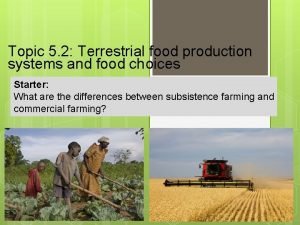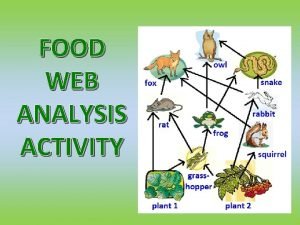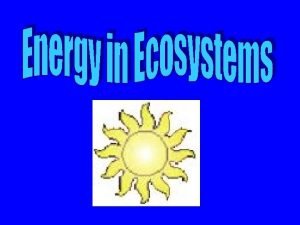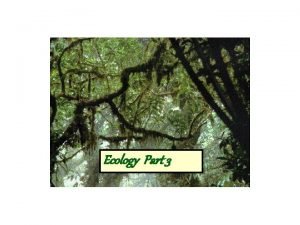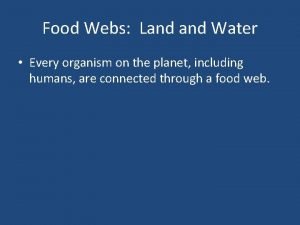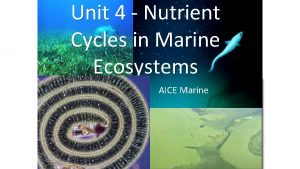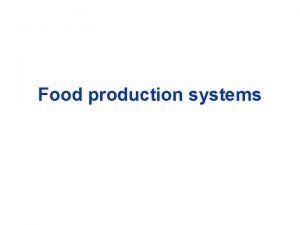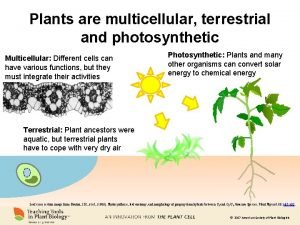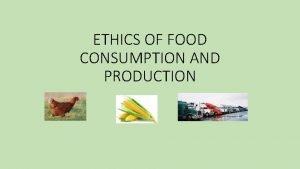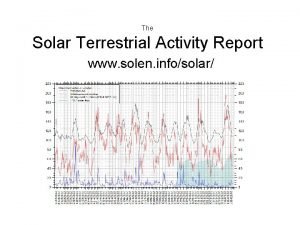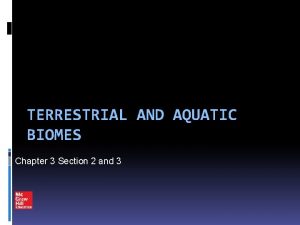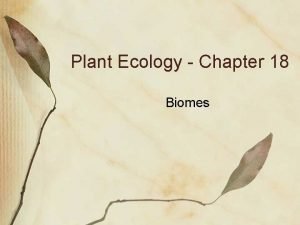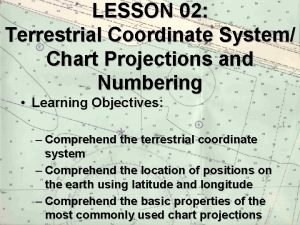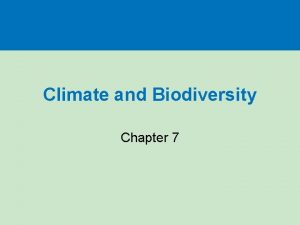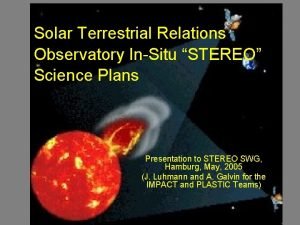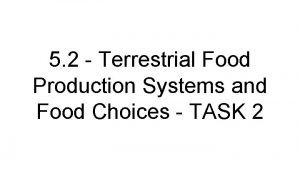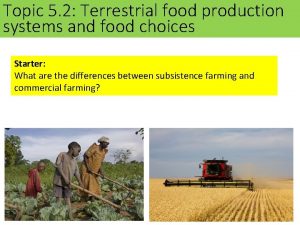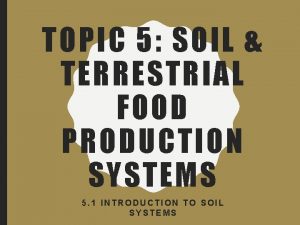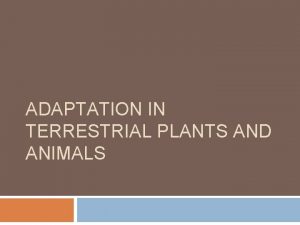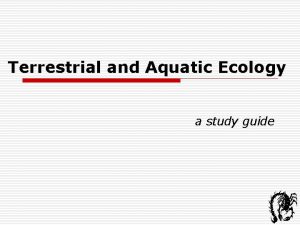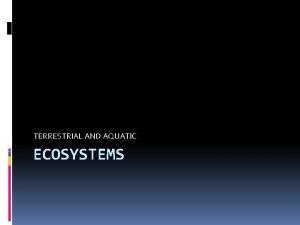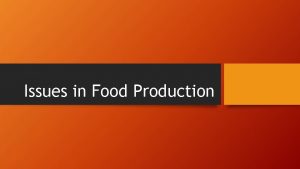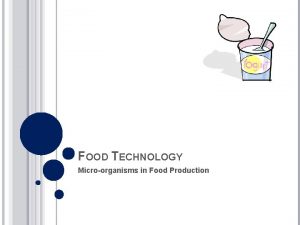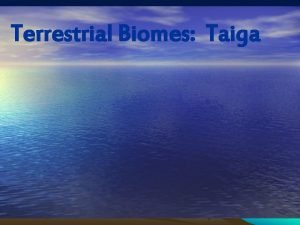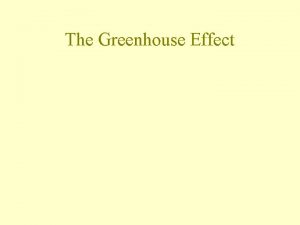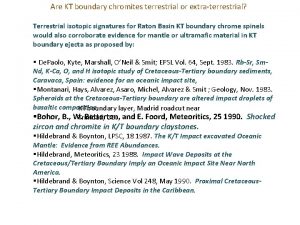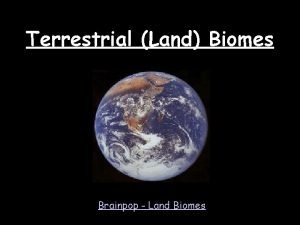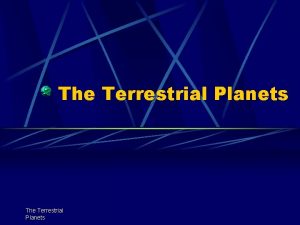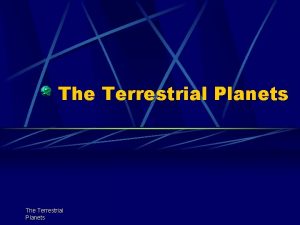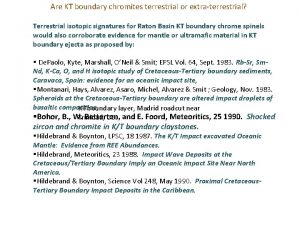Topic 5 2 Terrestrial food production systems and






























- Slides: 30

Topic 5. 2: Terrestrial food production systems and food choices Starter: What are the differences between subsistence farming and commercial farming?

Definitions LEDC – Less economically developed country MEDC – More economically developed country Agribusiness – All business associated with agriculture Commercial agriculture – large scale production of crops and livestock for sale Subsistence agriculture – farming for self-sufficiency to grow enough for a family

Think About It Even though our world produces enough food for everyone, about one in eight of us still goes to bed hungry each night. What are some of the reasons that people go hungry? Can you name some places in the world where people are experiencing hunger right now? What are some specific things we as individuals can do to help end hunger for others, locally and globally?


What is the Problem 870 million people (1 in 8) suffer from chronic undernourishment (deficiency of calories and protein) worldwide Poor nutrition plays a role in at least half of the 10. 9 million child deaths each year

What is the Problem The world produces enough food to feed every person on earth (actually in excess) however it is lack of transportation, access to land, water, and money to distribute this food that creates the shortages Poverty, harmful economic systems, conflict, and climate change all contribute to the problem

Inequalities ¾ of the world is inadequately fed with about 1 billion going hungry Too much food is being produced in MEDCs leading to surplus and lowered price of food.

Inequalities Some MEDCs have import tariffs which make the import of food more expensive. LEDC food production is often used as a way to generate foreign income from cash crops leading to an emphasis on export, rather than feeding the local populations

Inequalities Long-standing imbalance between rich and poor countries in international agricultural trade. Domestic support and export subsidies to farmers in MEDCs make LEDC crops uncompetitive.

Inequalities Increased meat/dairy consumption and biofuel use pushes prices up as land isn’t used for food crops. Climate change with higher temps in tropical and subtropical areas can lead to crop loss.

Inequalities MEDC farms are very technocentric, whereas LEDC farms are very labor intensive (usually from within the family. )

Using the table to answer the following question Explain why subsistence farming could be considered more sustainable than commercial farming? (6)

Which is more sustainable? Factor Agribusiness Scale of farming Industrialisation Mechanisation Fossil fuel use Seed/crop/livestock choices Water use Fertilisers, pest control Antibiotics Legislation Pollinators Commercial farming: most Subsistence farming: in MEDCs mostly in LEDCs

Farming Systems Subsistence Production No Farming food for family surplus Human and animal labor Mixed crops Low inputs of energy Cash cropping

Farming Systems Commercial Production Farming for profit Maximizing yield High level of technology Monocultures High inputs of energy Extensive- more land with lower planting Intensive – use land more intensively

Farming Systems Pastoral Farming Raising animals on grass and land not suitable for crops Arable Farming Growing crops on good soil to eat directly or feed to animals

Farming Systems Mixed Farming Crops and animals Animal waste used to fertilize crops Crops used to feed animal

Food waste http: //your. asda. com/news-and-blogs/asda-s-phenomenal-wonky-veg-coming-toa-store-near-you

Food is also wasted in LEDCs but for different reasons. Political, economic agendas e. g. Robert Mugabe, Zimbabwe Cash crops



Some cultures prefer to harvest food from higher trophic levels Western culture – generally primary consumers Some eastern cultures – dog (secondary consumer) Other cultures – seals, other aquatic organisms of higher trophic level

MEDC’s vs LEDC’s Cost of food relatively Surplus of food stores Food choice based on preference not nutritional need Technology and transportation systems allow imports and food produced year round Struggle to produce enough food for population Political, economic and environmental limits on food Food choice determined availability Seasonal Cash cropping

MEDC’s vs LEDC’s Average energy intake 3314 calories per day 12. 9% from meat 1. 4% from fish 37. 3% from cereals Average energy intake 2666 calories per day 7. 3% from meat 0. 9% from fish 56. 1% from cereals

What determines food choices Climate Irrigation Cultural and greenhouse and Religious influences Hindu – no beef, Islam – no pork, Buddhism vegetarian Politics subsidies and tariffs Socio-economics Supply and demand, affordability

Compare 2 farming systems in detail Inputs – fertilisers, water, pest control, labour, seed etc. Outputs – food quality, yield, pollutants, transport, processing, packaging etc. System characteristics – diversity, sustainability etc. Environmental impacts – pollution, habitat/biodiversity loss, soil erosion/degredation, desertification, disease etc. Socio-economic factors – Subsistence/commercial, traditional? , local/export, quality/quantity

Compare 2 farming systems in detail Some examples: Intensive beef production in South American vs. Extensive beef production by Masai tribe in Africa. Cereal farming in North America vs. subsistence farming in SE Asia You could look at high intensity milk farming in the UK and organic milk production?

Aquatic vs Terrestrial is a more efficient use of solar energy (1 st/2 nd trophic level) Less solar energy reaches aquatic systems (reflection and absorption by water) Aquatic often higher trophic level (4+) Aquatic systems more efficient in terms of passing energy along food chain More skeletal waste in terrestrial (terrestrial animals need more substantial bones to support themselves on land)

How can we be more sustainable? Population is growing, available agricultural land is decreasing due to soil erosion, salinization, urbanization and desertification.

How can we be more sustainable? Use the i. Pads to research the following, find example of each: 1. 2. 3. 4. 5. 6. 7. 8. Altering human activity Maximize yield Local produce Food Labels Monitoring multi-nationals Buffer zones (nutrient run-off) Food Waste Changing attitudes about food diets
 Terrestrial food production systems
Terrestrial food production systems Production pre production post production
Production pre production post production Freshwater food web
Freshwater food web Food web bearded dragon food chain
Food web bearded dragon food chain 3 primary consumers
3 primary consumers Food chain of land
Food chain of land A terrestrial food web
A terrestrial food web Different types of food production systems
Different types of food production systems Clincher example
Clincher example Narrowing down a topic exercises
Narrowing down a topic exercises Unit 2 food food food
Unit 2 food food food Grazing food chain diagram
Grazing food chain diagram Free enterprise system def
Free enterprise system def Terrestrial plant
Terrestrial plant Differences between aquatic and terrestrial ecosystems
Differences between aquatic and terrestrial ecosystems Ethics of food production and consumption
Ethics of food production and consumption Module 10 topic 1 drivers ed
Module 10 topic 1 drivers ed Surface of terrestrial planets
Surface of terrestrial planets Solen.info
Solen.info What is the 2nd smallest planet in our solar system
What is the 2nd smallest planet in our solar system My very excited mother just
My very excited mother just What is a terrestrial biome
What is a terrestrial biome Chapter 3 section 2 terrestrial biomes
Chapter 3 section 2 terrestrial biomes Terrestrial navigation
Terrestrial navigation Terrestrial soil
Terrestrial soil What are biomes defined by
What are biomes defined by Inner terrestrial planets
Inner terrestrial planets Terrestrial coordinate system
Terrestrial coordinate system Human impact on terrestrial ecosystems
Human impact on terrestrial ecosystems Terrestrial biomes summary chart
Terrestrial biomes summary chart Solar terrestrial relations observatory
Solar terrestrial relations observatory
